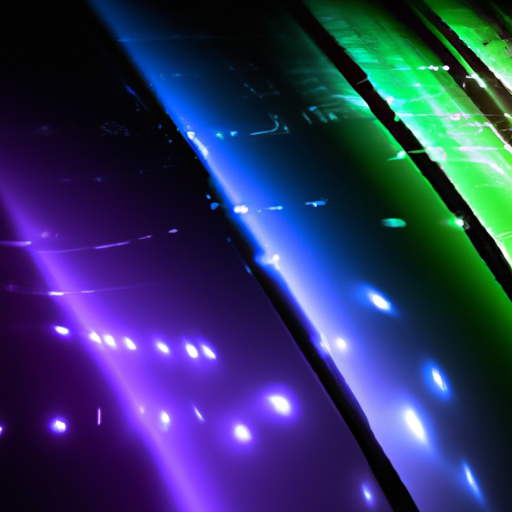In this article, “Understanding OLED Basics,” you will learn the fundamentals of OLED technology. OLEDs, or organic LEDs, are made with organic materials and provide diffuse-area light. While their development has been rapid, OLEDs are still not widely used for general illumination due to their high cost. This article explores the structure and advantages of OLEDs, such as their energy-saving potential and versatile design capabilities. The future of OLEDs is promising, with improvements in efficacy, color rendering index, and lifetime, but there are still challenges to overcome, particularly in reducing costs. Read on to gain a deeper understanding of OLED basics and their potential impact on lighting technology.

Structure of OLEDs
OLEDs, or organic light-emitting diodes, have a unique structure that sets them apart from other lighting technologies. These devices consist of a thin, carbon-based semiconductor layer that emits light when electricity is applied by adjacent electrodes. Unlike traditional LEDs, OLEDs are made in sheets, making them diffuse-area light sources. This allows for a more even distribution of light, eliminating the need for shades, diffusers, lenses, and other light control accessories. Furthermore, at least one of the electrodes in an OLED must be transparent to allow light to escape from the device. By controlling the amount of electric current applied and the type of emissive material used, OLEDs can produce different intensities of light and a wide range of colors.
Thin, carbon-based semiconductor layer
The key component of an OLED is its thin, carbon-based semiconductor layer. This layer is responsible for emitting light when electricity is applied. The use of organic materials in this layer allows for flexibility and ease of manufacturing, making OLEDs ideal for applications that require bendable or curved displays.
Emission of light with electricity
When an electric current is applied to an OLED, electrons and holes recombine within the organic semiconductor layer. This recombination process results in the emission of light. The color of the light emitted depends on the specific organic materials used in the OLED.
At least one transparent electrode
In order for light to escape from an OLED, at least one of the electrodes must be transparent. This allows the light to be visible to the user and creates a more diffuse light source compared to concentrated LEDs.
Control of light intensity and color
The intensity of light emitted by an OLED can be controlled by adjusting the amount of electric current applied. By varying the current, OLEDs can produce different levels of brightness. Additionally, the color of OLED light can be determined by the specific organic materials used in the emissive layer. By combining red, green, and blue emitters, OLEDs can create white light or a wide range of colors.
Advantages of OLEDs
OLED technology offers several advantages over traditional lighting sources. These advantages make OLEDs a versatile and visually appealing option for lighting applications.
Diffuse light source
Unlike concentrated LEDs, OLEDs are diffuse light sources. This means that the light emitted spreads out evenly over a larger area. The diffuse nature of OLEDs eliminates the need for additional light control accessories such as shades, diffusers, and louvers. This results in a softer, more even illumination that is comfortable to the human eye.
Less glare
The diffuse nature of OLED lighting also means that it creates less glare compared to traditional light sources. Glare can be uncomfortable and can cause eyestrain, especially in work or task environments. With OLEDs, the light can be placed closer to the task surface without creating excessive glare, providing a more comfortable and productive lighting environment.
Thin and visually appealing
OLEDs are incredibly thin and can be made to almost any shape. This allows for innovative designs and the creation of visually appealing lighting fixtures. OLEDs can be attached to the surfaces of walls, ceilings, and other objects, providing a unique lighting experience. The thin profile of OLEDs also adds to their aesthetics and makes them suitable for various applications where space is limited.
Flexible shape and design possibilities
One of the most notable advantages of OLEDs is their flexibility. OLEDs can be deposited on flexible substrates, allowing for bendable and curved displays. This flexibility opens up a whole new realm of design possibilities, enabling the creation of unique lighting fixtures and products. OLEDs can be used in applications such as flexible displays, curved lighting panels, and even wearable lighting.

Commercial OLED Offerings
The commercial availability of OLED technology has expanded in recent years, offering consumers more options for lighting solutions.
Bendable OLED panels
One of the notable commercial offerings of OLED technology is the availability of bendable OLED panels. These panels can be flexed and bent to fit various applications, making them highly versatile and adaptable. Bendable OLED panels offer the same energy-saving potential as traditional OLEDs, with efficacy levels exceeding 60 lumens per watt (lm/W).
Efficacies >60 lm/W
OLED technology has reached efficacies of over 60 lm/W, making it a competitive option in terms of energy efficiency. These high efficacy levels allow OLEDs to provide bright and efficient lighting while consuming less energy compared to traditional light sources.
Flexible design possibilities
The flexibility of OLED technology extends beyond its physical bending capabilities. OLEDs offer a wide range of design possibilities due to their thinness and ability to be made in unique shapes. This opens up opportunities for innovative lighting fixtures and architectural integration. With OLEDs, designers and manufacturers can explore new possibilities and create lighting solutions that are both aesthetically pleasing and highly functional.

Future of OLEDs
While OLED technology has made significant advancements, there are still areas for further development and improvements. The future of OLEDs looks promising as researchers and manufacturers work to overcome the remaining challenges.
Availability of high-efficiency panels
The continued development of OLED technology is expected to lead to the availability of even higher-efficiency panels. These panels would offer improved energy efficiency and brighter lighting outputs. High-efficiency OLED panels have the potential to become the go-to lighting solution for a wide range of applications, from residential to commercial and industrial.
Improvements in panel lifetime
One area of focus for OLED research is the improvement of panel lifetime. OLEDs have made significant strides in this area, with many products offering lifetimes of 30,000 to 50,000 hours of use before experiencing a decrease in light output. However, further advancements are needed to ensure the longevity and reliability of OLED lighting solutions, especially in demanding environments.
Cost as a barrier to market adoption
Despite the advantages of OLED technology, the current high cost of OLED panels remains a barrier to widespread market adoption. The high production costs associated with OLED manufacturing processes have limited their availability and affordability. To achieve commercial viability, OLED panel costs need to be significantly reduced.
Needed advancements for commercial viability
To overcome the cost barrier and achieve widespread commercial viability, advancements in OLED technology are necessary. These include improvements in manufacturing processes to reduce production costs, increased panel efficiency to provide better energy savings, and enhanced longevity to ensure reliable performance over an extended period. Future advancements may also focus on expanding the range of colors and improving color accuracy to meet specific lighting requirements.

OLED Basics
OLEDs, or organic light-emitting diodes, are a type of lighting technology that utilizes organic (carbon-based) materials as key building blocks. Unlike traditional LEDs, which are small-point light sources, OLEDs are made in sheets that serve as diffuse-area light sources. This unique structure allows for a softer and more even distribution of light, creating a comfortable illumination experience.
Definition and origin of OLEDs
OLEDs are a type of solid-state lighting device that emits light when electricity is applied. The concept of OLEDs dates back to the early 1960s when researchers discovered that certain organic materials could produce light when an electric current passed through them. The commercial development of OLED technology started in the late 1980s and has since evolved into various applications, including lighting and displays.
Comparison with LEDs
While OLEDs and LEDs both utilize semiconductors to emit light, they differ in terms of their structure and light-emitting properties. LEDs are small-point light sources that emit bright and concentrated light. In contrast, OLEDs are diffuse-area light sources that produce a softer and more even distribution of light. This makes OLEDs suitable for applications where glare reduction and visual comfort are essential.
Product offerings and development
OLED technology has seen significant development and advancements in recent years. Several product offerings are available in the market, ranging from OLED lighting panels to OLED displays. These products showcase the capabilities of OLED technology, including its flexibility, thinness, and visual appeal. Ongoing research and development efforts aim to further improve OLED performance, efficiency, and cost-effectiveness.
